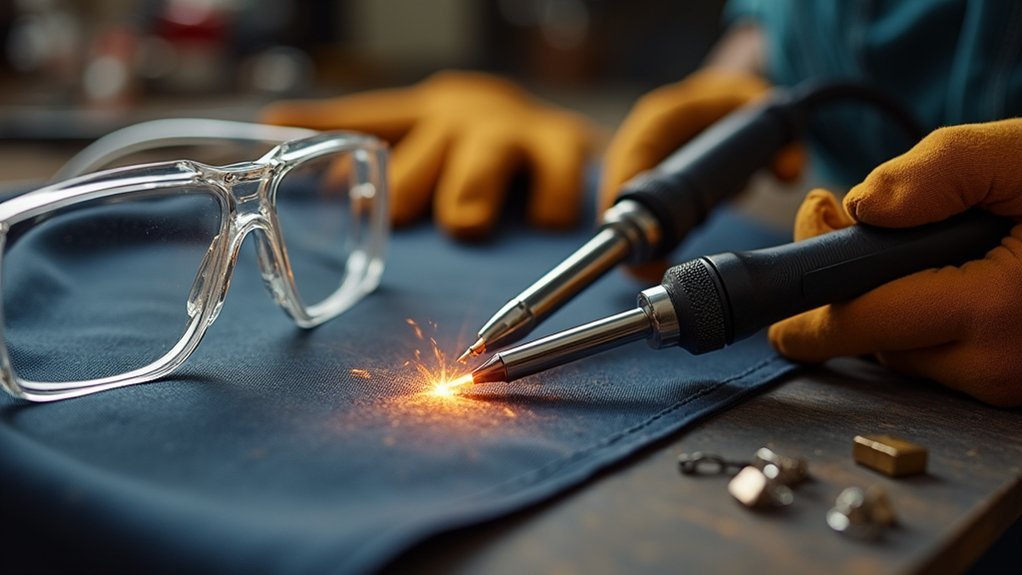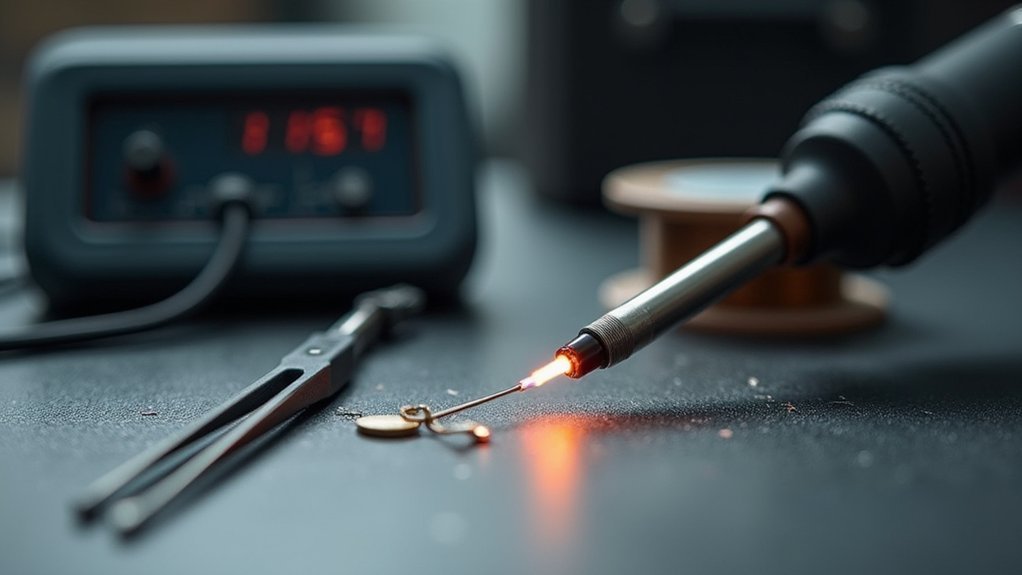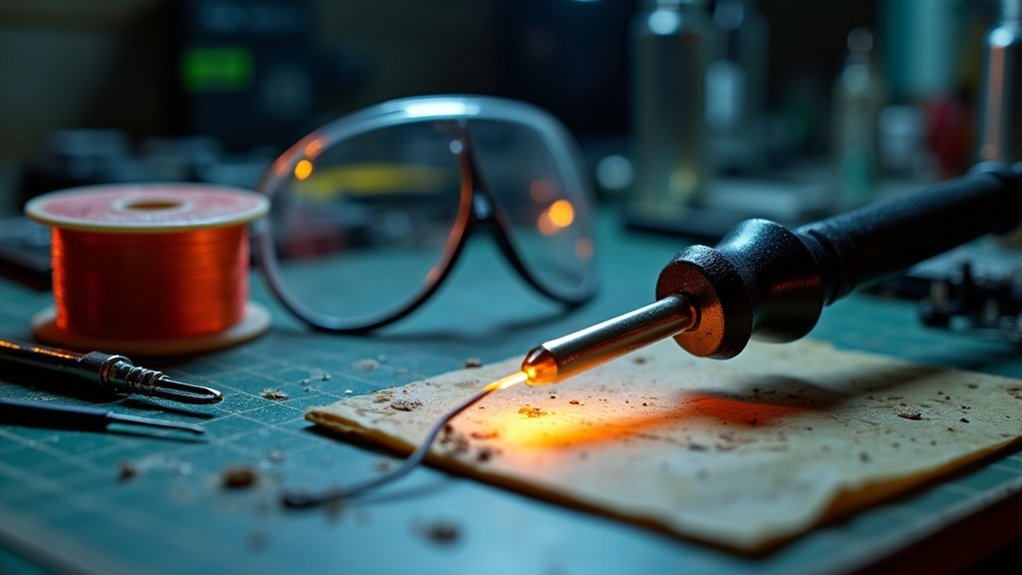You’ll need proper ventilation and PPE including safety goggles, heat-resistant gloves, and a quality respirator to protect against toxic fumes and burns. Set up your workspace with fire-resistant surfaces, keep fire extinguishers accessible, and use fume extraction systems with HEPA filters. Choose lead-free solder when possible, maintain iron temperatures between 350-400°C, and always return tools to their stands immediately after use. Follow proper cleanup procedures and dispose of waste materials according to safety guidelines for complete protection.
Essential Personal Protective Equipment for Jewelry Soldering

When working with high temperatures and molten metals, you’ll need proper protective equipment to safeguard yourself during jewelry soldering.
Safety goggles are essential to shield your eyes from splashing molten solder and dangerous spitting. Heat-resistant gloves made of leather or non-flammable materials protect your hands from burns caused by hot tools.
Essential eye and hand protection prevents serious burns and injuries when working with hot soldering tools and molten metals.
You’ll want a quality respirator to filter harmful fumes, particularly when using rosin-based solder that can damage your respiratory system. Flame-resistant clothing made of 100% cotton minimizes burn risks from sparks and hot materials.
An anti-static wrist strap prevents static electricity from damaging sensitive electronic components commonly found in modern jewelry.
This protective equipment creates multiple safety barriers between you and potential hazards.
Proper Workspace Setup and Ventilation Requirements
You’ll need to establish a well-organized, clutter-free workspace that prioritizes both safety and efficiency for your soldering projects.
Your setup must include proper fume extraction systems with HEPA and activated carbon filters to protect you from harmful vapors and particles.
Additionally, you should work on fire-resistant surfaces and keep fire extinguishers easily accessible to prevent and respond to potential fire hazards.
Clean Workspace Organization
A well-organized workspace forms the foundation of safe soldering practices, directly impacting both your safety and the quality of your work. Clean workspace organization begins with removing unnecessary objects and clutter that create distractions and fire hazards around soldering irons.
You’ll want to maintain a clean environment by ensuring work surfaces remain dry and free from liquid spills, which can cause equipment malfunction and electric shock risks.
Regular workspace checks help you keep tools and materials easily accessible while eliminating health hazards. Organize your space so that safety practices become second nature.
Remember that adequate ventilation works hand-in-hand with workspace cleanliness—harmful fumes need clear pathways to escape effectively. This systematic approach to organization enhances your focus and creates safer soldering conditions.
Fume Extraction Systems
Proper fume extraction systems represent your primary defense against the respiratory hazards created during soldering operations. You’ll need fume extractors equipped with both activated carbon and HEPA filters to capture airborne contaminants effectively. Position these systems close to your soldering workspace to maximize capture efficiency.
| Component | Purpose | Maintenance |
|---|---|---|
| Activated Carbon Filter | Chemical contaminant removal | Replace every 6-12 months |
| HEPA Filter | Particulate matter capture | Replace annually |
| Ventilation System | Outside air dispersal | Test annually |
| Extraction Unit | Local exhaust ventilation | Monthly inspection |
Your health and safety depend on proper ventilation that ideally vents to the outside. Implement these safety measures by maintaining annual testing schedules and keeping detailed logs of filter changes. This approach minimizes respiratory risks from rosin-based solder fumes.
Fire-Resistant Surface Requirements
While effective fume extraction protects your respiratory health, establishing fire-resistant work surfaces forms an equally important foundation for soldering safety.
You’ll need fire-resistant surfaces that won’t ignite when hot soldering tools accidentally contact them. Keep your workspace dry and organized to prevent electrical malfunctions that create additional fire hazards.
Position your soldering equipment away from flammable materials like paper, fabric, or cleaning solvents. Regular workspace inspections help identify potential risks before they become dangerous.
You should know where fire extinguishers are located and understand their proper operation. If a fire starts during soldering, quick access to suppression tools can prevent small incidents from becoming major emergencies that threaten your safety.
Understanding Solder Types and Flux Safety in Jewelry Making
You’ll want to choose lead-free solder for jewelry making since it eliminates the serious health risks associated with toxic lead-based alternatives.
Lead-free options containing tin and copper provide effective results while keeping you safer during extended soldering sessions.
When working with rosin flux, you must maintain proper ventilation since the fumes can irritate your respiratory system and cause long-term health problems if inhaled regularly.
Lead-Free Solder Benefits
Although traditional lead-based solders have dominated jewelry making for decades, lead-free alternatives offer significant health and safety advantages that you can’t ignore.
Lead-free solder eliminates exposure risks that cause serious health effects like anemia and neurological damage. These safer alternatives, containing tin, copper, silver, and zinc, create strong joints while protecting your wellbeing.
You’ll notice lead-free solders require higher melting temperatures, so adjust your technique accordingly. Pair them with rosin flux, which is less corrosive than acid-based options and protects delicate metals.
Even when soldering electronic components or jewelry, maintain proper ventilation since higher temperatures can produce toxic fumes. Following these soldering safety practices guarantees you’ll achieve professional results while minimizing health risks throughout your creative process.
Rosin Flux Precautions
Rosin flux requires careful handling despite being gentler than acid-based alternatives. When soldering, you’ll need proper ventilation since heated rosin produces harmful fumes that threaten your health.
Direct skin exposure can trigger colophony dermatitis, causing uncomfortable itching and redness.
Essential rosin flux safety measures include:
- Ventilation systems – Install fume extraction equipment to remove toxic vapors from your workspace
- Personal protection – Wear gloves consistently to prevent skin contact and potential allergic reactions
- Proper disposal – Follow hazardous waste guidelines when discarding flux-contaminated materials
Even though rosin flux creates non-corrosive residue that doesn’t require immediate removal, you should clean accumulated buildup over time.
Whether you’re using traditional lead-based or modern lead-free solder, maintaining these safety protocols protects against long-term health risks from repeated exposure.
Temperature Control and Tool Handling Best Practices

When setting your soldering iron to the ideal temperature range of 350°C to 400°C (662°F to 752°F), you’ll protect sensitive components while guaranteeing proper solder flow for reliable connections.
Your soldering station’s temperature control prevents overheating that damages delicate parts. Position the flat edge of your soldering iron tip against joints to maximize heat transfer efficiency.
Clean the tip regularly using a damp sponge to remove oxidation and maintain peak performance. Return your soldering iron to its stand immediately after each use—this handling soldering iron practice prevents burns and fire hazards in your work area.
Apply solder directly to heated joints, not the iron itself, creating stronger connections. Following proper safety protocols while maintaining these temperature control habits guarantees consistent results and a secure workspace.
Fume Management and Respiratory Protection
Beyond maintaining proper temperature control, you must address the invisible hazards floating in your workspace air. Soldering fumes from rosin-core materials can cause serious respiratory issues and worsen asthma symptoms. Proper ventilation isn’t optional—it’s crucial for protecting your health.
Temperature control alone won’t protect you—invisible soldering fumes pose serious respiratory threats that demand immediate ventilation solutions.
Install fume extraction systems that capture harmful particles at their source and vent them outside. These systems transform dangerous soldering fumes into manageable hazardous waste through effective filtration.
Key protective measures include:
- Using personal protective equipment like particulate respirators in poorly ventilated areas
- Monitoring for warning signs such as eye irritation, headaches, and breathing difficulties
- Regularly inspecting and maintaining extractors, replacing filters to guarantee peak performance
Don’t ignore symptoms of fume exposure. Your respiratory health depends on implementing thorough protection strategies consistently.
Fire Prevention and Emergency Preparedness

While fume extraction protects your lungs, fire prevention safeguards your entire workspace and personal safety.
Always work on fire-proof surfaces to minimize ignition risks during soldering tasks. You’ll need to familiarize yourself with your nearest fire extinguisher’s location and proper use for quick emergency response.
Regular inspection of your soldering equipment and electrical cables prevents electrical fires and guarantees safe operation. Implement a thorough fire prevention plan in your workspace to identify potential hazards and establish safe soldering protocols.
Don’t forget to conduct annual reviews and maintenance of your fume extraction systems—they’re essential for proper function and mitigating fire risks from soldering fumes.
This safety information forms the foundation of effective emergency preparedness.
Post-Soldering Safety Procedures and Waste Disposal
After completing your soldering work, you’ll need to handle cleanup and waste disposal with the same care you applied during the actual soldering process.
Turn off your iron and allow it to cool completely before storing it safely.
Proper waste management requires attention to detail:
- Collect all waste solder and contaminated materials in labeled, lidded containers for hazardous waste disposal.
- Place used sponges and cleaning rags in sealable bags for proper hazardous waste processing.
- Follow Safety Office guidelines for disposal methods to guarantee regulatory compliance.
Always wash your hands thoroughly with soap and water after handling any soldering materials to remove potential lead or chemical residues.
Clean your work area completely, removing any solder particles or flux residue.
Report any incidents to safety personnel for assessment.
Frequently Asked Questions
What Are the Safety Rules for Soldering?
You’ll need eye protection, flame-resistant clothing, and proper ventilation. Keep your workspace organized and dry. Maintain tools with current safety testing. Dispose of waste properly and follow health surveillance procedures.
What Are the OSHA Requirements for Soldering?
You must provide proper ventilation systems and fume extractors, supply required PPE like safety goggles and gloves, maintain electrical equipment regularly, and guarantee proper labeling and employee training for hazardous materials.
What Is the Number 1 Rule of Soldering?
You must always place your soldering iron in its stand when you’re not using it. This prevents dangerous burns and fire hazards that could seriously injure you or damage your workspace.
How to Make Soldering Safe?
You’ll make soldering safe by wearing protective gear, ensuring proper ventilation, inspecting tools regularly, keeping your workspace organized with fire-resistant surfaces, and disposing of hazardous materials correctly.
In Summary
You’ll protect yourself and create quality jewelry by following these soldering safety practices. Don’t skip the protective gear, maintain proper ventilation, and keep your workspace organized. You’ve learned about fume management, fire prevention, and proper waste disposal—all vital for safe metalwork. Make these habits second nature in your practice. Your health and craftsmanship depend on consistent safety measures every time you pick up that torch.





Leave a Reply